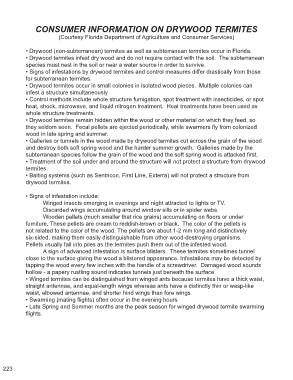Page 223 - Florida Pest Control Examinations
P. 223
CONSUMER INFORMATION ON DRYWOOD TERMITES
(Courtesy Florida Department of Agriculture and Consumer Services)
• Drywood (non-subterranean) termites as well as subterranean termites occur in Florida.
• Drywood termites infest dry wood and do not require contact with the soil. The subterranean
species must nest in the soil or near a water source in order to survive.
• Signs of infestations by drywood termites and control measures differ drastically from those
for subterranean termites.
• Drywood termites occur in small colonies in isolated wood pieces. Multiple colonies can
infest a structure simultaneously
• Control methods include whole structure fumigation, spot treatment with insecticides, or spot
heat, shock, microwave, and liquid nitrogen treatment. Heat treatments have been used as
whole structure treatments.
• Drywood termites remain hidden within the wood or other material on which they feed, so
they seldom seen. Fecal pellets are ejected periodically, while swarmers fly from colonized
wood in late spring and summer.
• Galleries or tunnels in the wood made by drywood termites cut across the grain of the wood
and destroy both soft spring wood and the harder summer growth. Galleries made by the
subterranean species follow the grain of the wood and the soft spring wood is attacked first.
• Treatment of the soil under and around the structure will not protect a structure from drywood
termites.
• Baiting systems (such as Sentricon, First Line, Exterra) will not protect a structure from
drywood termites.
• Signs of infestation include:
Winged insects emerging in evenings and night attracted to lights or TV.
Discarded wings accumulating around window sills or in spider webs.
Wooden pellets (much smaller that rice grains) accumulating on floors or under
furniture. These pellets are cream to reddish-brown or black. The color of the pellets is
not related to the color of the wood. The pellets are about 1-2 mm long and distinctively
six-sided, making them easily distinguishable from other wood-destroying organisms.
Pellets usually fall into piles as the termites push them out of the infested wood.
A sign of advanced infestation is surface blisters. These termites sometimes tunnel
close to the surface giving the wood a blistered appearance. Infestations may be detected by
tapping the wood every few inches with the handle of a screwdriver. Damaged wood sounds
hollow - a papery rustling sound indicates tunnels just beneath the surface.
• Winged termites can be distinguished from winged ants because termites have a thick waist,
straight antennae, and equal-length wings whereas ants have a distinctly thin or wasp-like
waist, elbowed antennae, and shorter hind wings than fore wings.
• Swarming (mating flights) often occur in the evening hours
• Late Spring and Summer months are the peak season for winged drywood termite swarming
flights.
223

